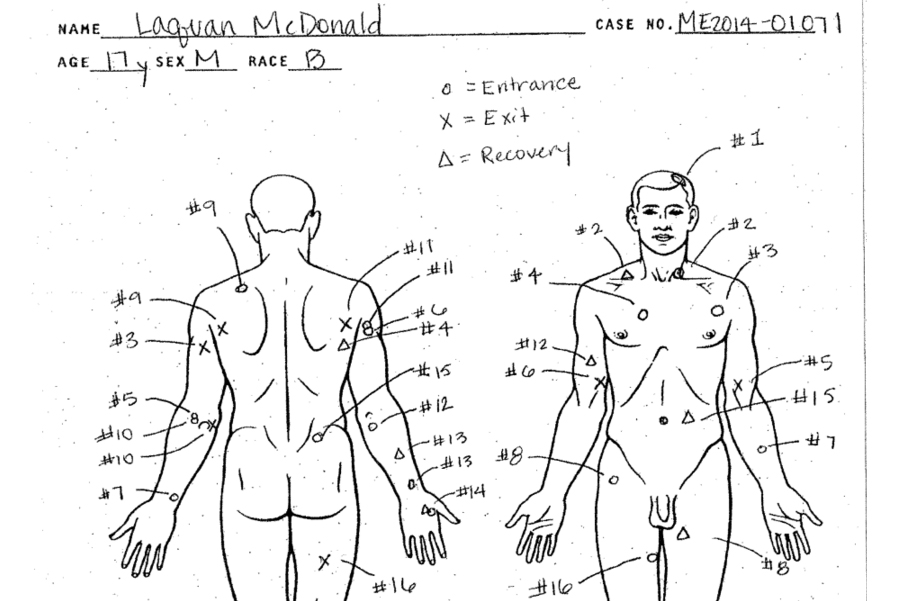It was just about a year ago that a city whistleblower came to journalist Jamie Kalven and attorney Craig Futterman out of concern that Laquan McDonald’s shooting a few weeks earlier “wasn’t being vigorously investigated,” as Kalven recalls. The source told them “that there was a video and that it was horrific,” he said.
Without that whistleblower—and without that video—it’s highly unlikely that Chicago Police officer Jason Van Dyke would be facing first-degree murder charges today.
RELATED: Protests In Chicago Over Video Of Police Execution Of Black Teenager [WATCH]
ALSO READ: Brutal Video Shows White Cop Body Slamming 16-Year-Old Black Girl In School [WATCH]
“When it was first reported it was a typical police shooting story,” Kalven said, where police claim self-defense and announce an investigation, and “at that point the story disappears.” And, typically, a year or 18 months later, the Independent Police Review Authority confirms the self-defense claim, and “by then no one remembers the initial incident.”
“There are an average of 50 police shootings of civilians every year in Chicago, and no one is ever charged,” said Futterman. “Without the video, this would have been just one more of 50 such incidents, where the police blotter defines the narrative and nothing changes.”
Last December, Kalven and Futterman issued a statement revealing the existence of a dash-cam video and calling for its release. Kalven tracked down a witness to the shooting, who said he and other witnesses had been “shooed away” from the scene with no statements or contact information taken.
In February, Kalven obtained a copy of McDonald’s autopsy, which contradicted the official story that McDonald had died of a single gunshot to the chest. In fact, he’d been shot 16 times—as Van Dyke unloaded his service revolver, execution style—while McDonald lay on the ground.

The next month, the City Council approved a $5 million settlement with McDonald’s family, whose attorneys had obtained the video. They said it showed McDonald walking away from police at the time of the shooting, contradicting the police story that he was threatening or had “lunged at” cops. The settlement included a provision keeping the video confidential.
“The real issue here is, this terrible thing happened, how did our governmental institutions respond?” Kalven said. “And from everything we’ve learned, compulsively at every level, from the cops on the scene to the highest levels of government, they responded by circling the wagons and by fabricating a narrative that they knew was completely false.” To him this response is “part of a systemic problem” and preserves “the underlying conditions that allow abuse and shield abuse.”

In April, the Chicago Tribune revealed Van Dyke’s name and his history of civilian complaints—including several brutality complaints, one of which cost the city $500,000 in a civil lawsuit—none of which resulted in any disciplinary action. In May, Carol Marin reported that video from a security camera at a Burger King on the scene had apparently been deleted by police in the hours after the shooting.
“This case shows the operation of the code of silence in the Chicago Police Department,” said Futterman. “From the very start you have officers and detectives conspiring to cover up the story. The question is, why are they not being charged?”
Van Dyke’s history “also shows what happens when the police department consistently chooses not to look at patterns of abuse complaints when investigating misconduct charges,” he adds. This failure “is one of the reasons an officer like Van Dyke has an opportunity to execute a 17-year-old kid.”
Rather than acknowledging the systemic failures, Mayor Rahm Emanuel is now trying to frame the issue as the action of one bad officer, as the Tribune reports. “One individual needs to be held accountable,” he said Monday.
Kalven calls Emanuel’s “reframing” of the narrative “essentially false.” He points out that “everything we know now, the city knew from Day One. They had the officers on the scene. They knew there were witnesses. They had the autopsy, they had the video…. They maintained a false narrative about those events, and they did it for a year, when it could have been corrected almost immediately….They spent a year stonewalling any calls for transparency, any information about the case.”

He points to Cincinnati, where last summer a university officer was indicted for murder and video from his body camera was released within days following the shooting of an unarmed African-American man in a traffic stop.
“The policy in Cincinnati is that you should release within 24 hours unless there are compelling investigatory reasons to hold on longer,” said Kalven. “The policy should be that the presumption is that this is public information and it is released as quickly as can reasonably be done, except in cases where there is a genuine and very specific investigatory need to withhold it.”
That’s not the same as waiting until an investigation is concluded. Friday’s ruling that the McDonald video must be released—and the absence of any affidavit from investigators about the need to withhold it—showed that “there was absolutely no legal or investigatory impediment to releasing this” long ago.
“This was an incredible test of leadership, a major challenge to [Emanuel’s] leadership,” Kalven said. “Think how different the situation would be right now if the city had acknowledged the reality of what happened in the days or weeks after it happened. That would have built confidence.”
And instead of vague and politically self-serving calls for “healing,” it could have begun a real process of accountability of the kind necessary to start addressing the extreme alienation between police and wide segments of our communities.
Instead, with only Van Dyke indicted, it looks like he’s being sacrificed in order to protect the system that created him.
Culled from Chicago Reporters







